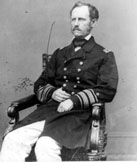Colonial Wars |
American Wars |
Link To This Page — Contact Us —
Rear Admiral John A.B. Dahlgren
 |
| NAME |
| Dahlgren, John Adolphus Bernard |
| BORN |
| November 13, 1809 Philadelphia, Pennsylvania |
| DIED |
| 1870 |
| ARMY |
| Union |
Dahlgren was the son of Bernhard Ulrik Dahlgren, a merchant and Swedish Consul in Philadelphia, Pennsylvania. He joined the U. S. Navy in 1826 as a midshipman and was promoted to the coastal survey in 1834. By 1847, he was an ordnance officer at the Washington Navy Yard. There, he carried out his initial assignments so well that the Chief of the Bureau of Ordnance and Hydrography assigned him increasing responsibilities, empowered him to expand the Yard’s facilities at his discretion, and arranged for him to remain on ordnance duty indefinitely. Under his command, the Navy established its own foundry, and its first product was the Boat Howitzer which was designed to be used on both ship and in landings. It is his cast iron cannon, the Dahlgren Gun, which was his most famous contribution.
In the early 1850's, Dahlgren launched the Ordnance Establishment, the first sustained Weapons Research & Development organization and program in American naval history. By 1856, the Dahlgren Gun had become the standard armament of the navy. One of the guns exploded while being tested in 1860, causing navy regulations to require the use of much lower levels of powder until into the start of the Civil War.
When the Civil War started, Dahlgren became the head of the Washington Navy Yard after Capt. Franklin Buchanan resigned that post to enlist in the Confederate cause. In 1862, he was promoted to captain and named head of the Navy Ordnance Bureau. In July 1863, he was promoted to rear admiral and assigned command of the South Atlantic Blockading Squadron.
Dahlgren weapons are usually divided into 3 groups - bronze boat howitzers and rifles, iron smoothbores, and iron rifles. Dahlgren developed the weapons primarily for use on small boats that patrolled the waterways. The necessity for these weapons was demonstrated by the Navy's experience during the Mexican War when small launches and other craft were assigned to patrol close to river and creek banks.
Dahlgren was a Lieutenant when he was assigned to the ordnance department at the Washington Navy Yard. The first weapon systems were adopted by the Navy in 1850. These pieces were specially designed for use on the small launches, but were also included on most naval vessels during the Civil War. His iron smoothbores were adopted in 1850 (9-inch gun) and 1851 (11-inch gun). Although these guns were designed for use against wooden ships, the iron-clad Monitor class ships carried 2 of these in their turrets. In 1864, he helped Major Gen. William T. Sherman secure Savannah, Georgia.
Dahlgren's son, Col. Ulric Dahlgren, was killed while carrying out an assassination plot against Jefferson Davis. The plot is known as the "Dahlgren Affair." Dahlgren was deeply troubled by his son's death and role in this event. He spent much of his later life advancing the theory that documents implicating Ulric had been forged.
By the end of the war, Dahlgren was responsible for the development and design of many boat howitzers in several weight classifications (small, medium, and light); many kind different size naval boat rifles.
After the Civil War, Dahlgren commanded the South Pacific Squadron for a year and a half before returning to Washington in 1868 to become chief of the Bureau of Ordnance once again. He served as commander until his death.
Dahlgren developed most of the ordnance that the U.S. Navy used during the Civil War. He would go down in history as the “father of American naval ordnance.”
Promotions:
- Captain -
- Rear Admiral - July ??, 1863
Major Commands:
- Washington Navy Yard
- South Atlantic Blockading Squadron
